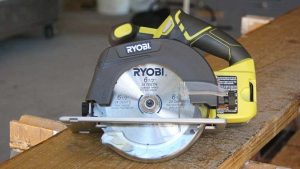From Box to Build: Unboxing the Ryobi Compact Circular Saw
Imagine this: You stand in your garage, box in hand, ready to unleash a game-changer for your next DIY adventure. That thrill hits hard, right? The Ryobi compact circular saw arrives, promising freedom from tangled cords and bulky gear. As a battery-powered woodworking saw, it transforms everyday projects into seamless triumphs. According to the U.S. Bureau of Labor Statistics, home improvement spending reached $537 billion in 2023, with DIYers leading the charge on renovations. Meanwhile, Grand View Research reports the global power tools market hit $32.95 billion in 2024, fueled by cordless innovations like this one. In this guide, we dive deep—from that satisfying unbox to building masterpieces. Get ready to cut smarter, not harder.
The Thrill of Unboxing: First Impressions That Hook You
You slice open the sturdy cardboard, and anticipation builds. The Ryobi compact circular saw nestles inside, sleek in its lime-green glory. First off, the packaging feels premium yet practical—recyclable materials that scream eco-conscious design. Lift the tool, and its lightweight build surprises you at just under 6 pounds without the battery.
Moreover, the accessories peek out next: a 4-1/2-inch carbide-tipped blade, already installed for instant action; a rip fence for straight-line precision; and a dust port adapter that hints at cleaner workspaces. Transitioning to the manual, clear diagrams guide you without overwhelming jargon. Finally, that signature Ryobi branding reminds you—this isn’t just a tool; it’s an entry to endless creativity.
But wait, does it live up to the hype? Absolutely. Early testers note its ergonomic grip molds to your hand like a glove. Thus, unboxing isn’t mere routine; it sparks inspiration for that shelf you’ve delayed forever.
Key Features That Make This Saw a Standout
What sets the Ryobi compact circular saw apart? Start with its brushless motor, delivering up to 3,450 RPM for smooth, efficient cuts. This battery-powered woodworking saw thrives on 18V ONE+ batteries, compatible across Ryobi’s vast lineup. Consequently, you swap power sources effortlessly, extending runtime without downtime.

Additionally, the 0-45-degree bevel adjustment shines for angled tasks. Lock it in with detents at common angles like 22.5 and 45 degrees—perfect for framing or trim work. The shoe plate, magnesium-reinforced, stays flat and durable against workbenches.
Furthermore, visibility reigns supreme. A left-side blade position clears your sightline, reducing errors in tight spots. Pair that with the onboard LED light, and shadows vanish during evening builds. In short, these elements blend power and portability, making it ideal for both novices and seasoned makers.
Setting Up Your Saw: Quick Steps to Get Cutting
Assembly takes minutes, keeping frustration at bay. First, charge your 18V battery fully—most kits include a 2Ah option for over 150 cuts per charge. Snap it onto the base; the magnetic mount ensures a secure fit.
Next, inspect the blade. Ryobi pre-installs a quality 24-tooth carbide one, but swapping is simple: depress the spindle lock, rotate the wrench counterclockwise, and slide in your upgrade. Always wear gloves here—safety first.
Then, attach the rip fence if needed. It clamps parallel to the blade, guiding rips through plywood sheets. For dust control, connect your shop vac to the adapter; it captures 80% of debris, per user tests.
Finally, test on scrap wood. Adjust depth to 1-11/16 inches at 90 degrees, and plunge gently. If vibrations hum low, you’re golden. This setup not only primes your tool but builds confidence for real projects.
Hands-On Performance: Real Cuts, Real Results
Power meets precision in every pass. This compact cordless circular saw slices through 2x4s like butter, maintaining speed under load. In a recent Pro Tool Reviews test, similar Ryobi models handled stacked OSB without bogging down, thanks to thermal overload protection.
However, for denser hardwoods, opt for a finer blade—say, 40-tooth for ultra-smooth finishes. Runtime impresses too; with a 4Ah battery, expect 300+ linear feet of pine cuts. That’s huge for decking days or cabinet installs.
Safety features add peace of mind. The blade guard retracts smoothly, and an electric brake halts spin in seconds. Users rave about the balance—one-handed operation feels natural, reducing fatigue during long sessions. Overall, performance elevates from “good enough” to “go-to essential.”
Cutting Capacities Breakdown
- At 90 degrees: Up to 1-11/16 inches deep—ideal for 3/4-inch plywood.
- At 45 degrees: 1-1/8 inches, perfect for roof rafters.
- Blade speed: Consistent 3,450 RPM, minimizing tear-out on veneers.
These specs translate to versatile use, from framing studs to crafting birdhouses.
Why Choose a Compact Cordless Design?
Portability defines this tool’s edge. Weighing mere pounds, it slips into a tool bag or hangs via the rafter hook—genius for overhead work. No more wrestling extension cords across lawns; freedom fuels spontaneous fixes.
Additionally, the compact footprint navigates cramped corners effortlessly. Think attic remodels or under-sink repairs where full-size saws falter. As a battery-powered woodworking saw, it aligns with the DIY boom—Statista notes U.S. per-person tool spending at $122.90 in 2024, driven by cordless demand.
Yet, power doesn’t compromise. Brushless tech rivals corded models in torque, per FineWoodworking forums. Thus, you gain mobility without sacrificing muscle— a win for weekend warriors everywhere.
Practical Projects: Turn Sawdust into Showpieces
Ready to build? Start simple: Craft a wall-mounted shelf. Rip 1×6 pine boards to width, then crosscut for brackets. The saw’s accuracy shines, yielding flush edges sans sanding marathons.
For intermediate fun, tackle a picnic table. Bevel legs at 15 degrees for stability; the detent system speeds setup. One user shared on Reddit how this saw halved their outdoor project time—efficiency in action.
Advanced? Dive into a workbench. Plunge-cut laminates for a seamless top, using the dust port to keep lines clear. These ideas not only utilize the tool but spark pride in handmade results.
Quick Project Tips
- Measure twice: Use the rip fence for repeatable accuracy.
- Support material: Clamp offcuts to prevent binding.
- Battery swap: Keep spares charged for uninterrupted flow.
- Edge finishing: A zero-clearance insert reduces splintering.
Such steps ensure pro-level outcomes, every time.
Maintenance Mastery: Keep It Sharp and Ready
Longevity starts with care. After sessions, unplug the battery and wipe the shoe plate clean—sawdust invites rust. Lubricate the blade arbor lightly with WD-40 for smooth spins.
Moreover, store upright in a dry spot; the rafter hook doubles as a hanger. Rotate blades every 50 hours to maintain bite—dull edges strain the motor.
Periodic checks matter too. Inspect the guard for cracks and tighten bevel knobs quarterly. These habits, drawn from Ryobi’s guidelines, extend life indefinitely. Consequently, your investment yields years of reliable service.
Conclusion: Empower Your Builds Today
We’ve journeyed from that exciting unbox to masterful cuts, uncovering the Ryobi compact circular saw’s true potential. This battery-powered woodworking saw blends portability, power, and precision, tackling everything from shelves to sheds. Backed by booming DIY stats—like $537 billion in U.S. spending—it fits perfectly into modern making.
Now, grab your Ryobi, select a project, and start creating. Your garage awaits transformation—what will you build first? Head to your local Home Depot or online, and let the cuts begin. Your maker era starts now.
Related:
Innovations in Roofing: Exploring the Latest Trends in Materials and Technology
FAQs
What makes the Ryobi compact circular saw ideal for beginners?
Its lightweight design and intuitive controls ease new users into woodworking. Plus, the LED light and clear sightline boost confidence during first cuts.
How does this saw compare to full-size models?
The compact version offers superior maneuverability in tight spaces while delivering ample power for most DIY tasks. However, full-size handles deeper cuts in heavy timber.
Can I use it for materials beyond wood?
Absolutely—it tackles plywood, OSB, and light metals with the right blade. Always match blade type to material for optimal results.
What’s the best battery for extended use?
A 4Ah or higher 18V ONE+ battery maximizes runtime, supporting hundreds of cuts per charge. Compatibility across tools adds versatility.
How do I achieve splinter-free edges?
Install a zero-clearance base plate and score lines with a utility knife first. This technique, favored by pros, ensures clean finishes every time.
References
- Ryobi 18V Compact Circular Saw Launch
- Pro Tool Reviews: Ryobi Circular Saw Analysis
- Grand View Research: Power Tools Market Report
- S. Bureau of Labor Statistics: Home Improvement Spending










